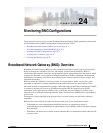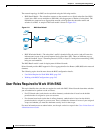
CHAPTER
23-1
Cisco Prime Network 4.0 User Guide
OL-29343-01
23
Monitoring IP Pools
An IP pool is a sequential range of IP addresses within a certain network. We can have multiple pool
configurations. Each pool can have a priority and can be assigned to a group.
IP addresses can be assigned dynamically from a single pool or from a group of pools. The Least
Recently Used (LRU) method is used to assign IP addresses. In each pool, the addresses are placed in a
queue. At the time of assigning, the address at the head of the queue is assigned, and when released is
placed at the end of the queue.
When a group of pools have the same priority, an algorithm is used to determine a probability for each
pool based on the number of available addresses. A pool is selected based on the probability determined.
This method allocates addresses evenly from the group of pools.
IP pool supports both IPv4 and IPv6 addresses. With the IP Pool feature, Prime Network provides the
flexibility of assigning IP addresses dynamically for services running on a network element. A service
running on a network element can refer to an appropriate IP pool and an IP address gets assigned to the
service from the IP pool.
This chapter contains the following topics:
• Viewing the IP Pool Properties, page 23-1
• Modifying and Deleting IP Pools, page 23-3
Viewing the IP Pool Properties
To view the IP pool properties for a device:
Step 1 In Prime Network Vision, right-click the required device, and choose Inventory.
Step 2 In the Inventory window, choose Logical Inventory > Context > IP Pools. A list of IP pools are
displayed in the content pane.
Table 23-1 describes the fields that are displayed in the content pane.
Table 23-1 IP Pool Properties
Field Name Description
Table Types Displays the type of table, which is IP Pools.
IP Pools
Name Name of the IP pool.
IP Pool Entries Indicates whether entries exist for this pool.


















